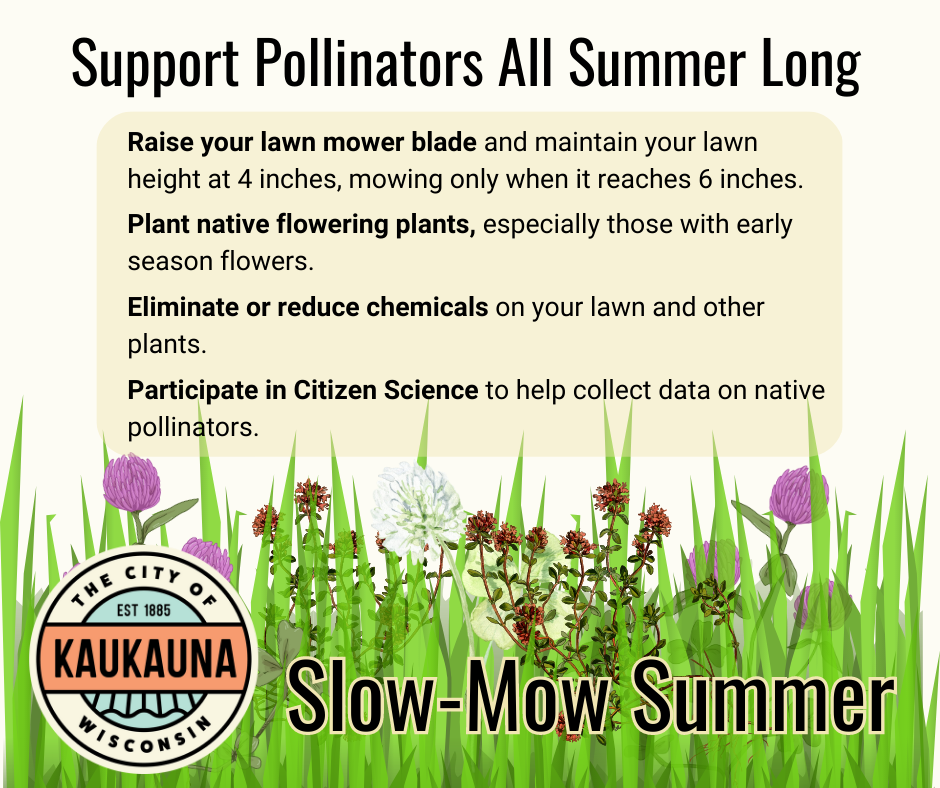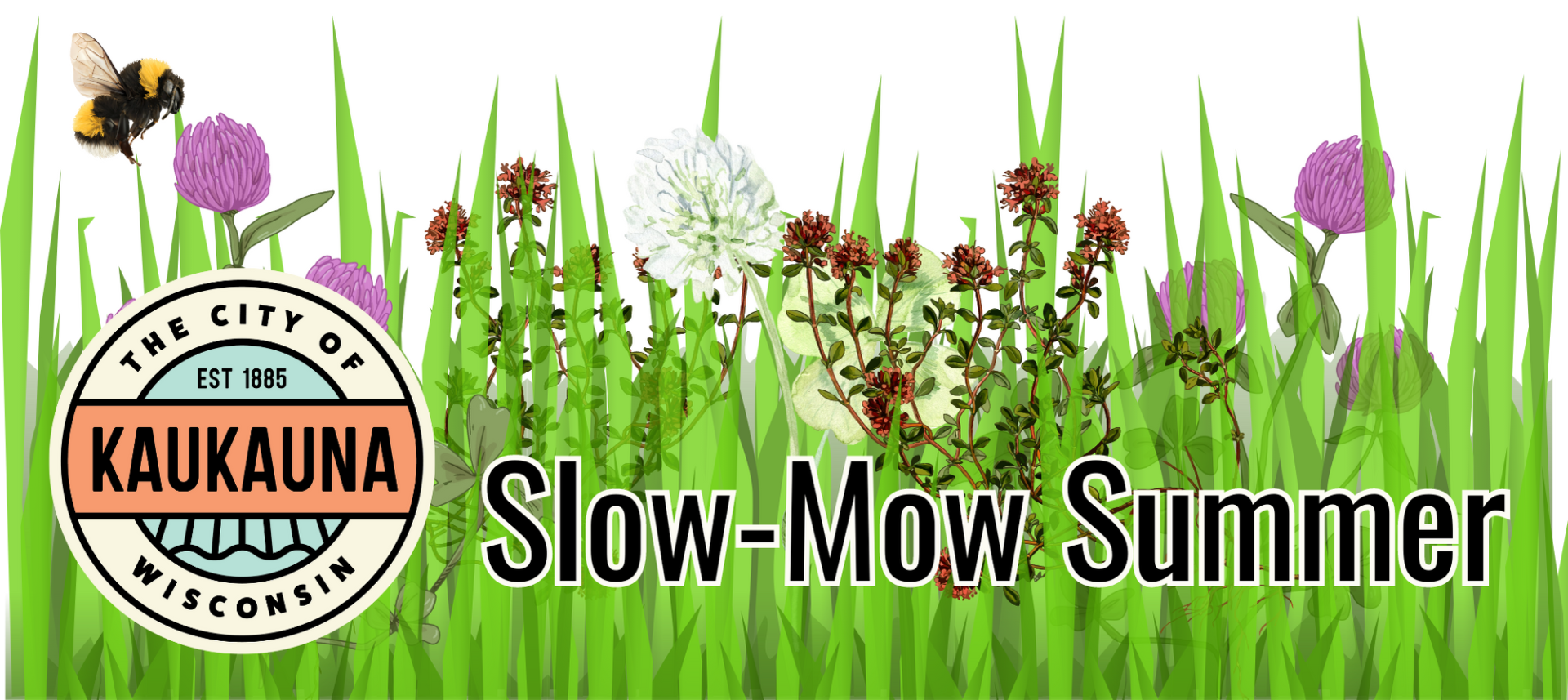
Move beyond No Mow May to support pollinators all summer long and beyond!
Pollinators, including bees, butterflies, birds, bats, and other small mammals, are responsible for 1 of every 3 bites of food you eat. Without these pollinators, our food systems as well as our natural ecosystems are in trouble. Although more research needs to be done to fully understand the decline of pollinator populations including the causes and effects, it is important to take action now to better support our pollinators.
The City of Kaukauna, along with 1000 Islands Environmental Center, is promoting pollinator friendly actions that anyone can take part in to create pollinator friendly yards. See below for steps that you can take throughout the growing season to create better habitat for bees and other pollinators.
MARCH
Warm early spring days often get people excited to get out into their yards and start some spring cleanup. It is important to be patient to let the days reach consistent warmer temperatures and allow overwintering insects to emerge before tidying up your yard and gardens. Learn more with the Xerces Society.
APRIL
Early spring is a great time to plant native trees and shrubs as the plants are still dormant and the ground is usually pretty saturated from melting snow and spring rain. 1000 Islands holds an annual Seedling Sale with native plant species that support birds and pollinators.
MAY
May is usually when things start greening up and growing in earnest. This is also one of the times of greatest growth in your lawns. Many communities encourage going the full month without mowing at all. In order to maintain the health of your lawn, including reducing the need for fertilizers or chemicals, consider reducing the frequency of your mowing instead of stopping altogether. This gives flowering plants such as dandelions and clover a chance to bloom, providing early season pollinator support while still allowing healthy root growth for your lawn and complying with your municipality’s noxious weed ordinance. For more information on healthy mowing practices, visit the University of Minnesota Extension Yard and Garden website.
JUNE
In addition to maintaining a higher grass height in your yard, remember to only cut a maximum of 1/3 of the grass height when mowing. As an example, to maintain 4″ of grass, only mow when the grass height reaches 6″. In addition to keeping your lawn healthier without the need for chemicals, this will result in a longer time in between mowing, reducing the disturbance to pollinators and other beneficial insects. In a study conducted by the U.S. Forest Service, it was concluded that “mowing less frequently is practical, economical, and a timesaving alternative to lawn replacement or even planting pollinator gardens. Given the pervasiveness of lawns coupled with habitat loss, our findings provide immediate solutions for individual households to contribute to urban conservation.”
JULY
Not all, but many of our pollinators are diurnal, or active during the day. Whenever possible, mow your lawns in the evening when much of the pollinator activity has slowed down for the day to reduce disturbance.
AUGUST
In the heat of the summer water is essential! We all know the importance of water for ourselves and our plants, but providing water sources for wildlife is important, too. Consider placing water sources in your yard for pollinators such as bees and butterflies. They are simple to create out of items that you already have around your house. Discover some water source ideas that will work for honey bees and native pollinators here.
SEPTEMBER
As the growing season starts to slow down, make sure to leave the stems of plants that are done growing, or going dormant, for the fall. Stems of various plants provide essential nesting and overwintering habitat for bees. Learn more about nesting and overwintering habitat with this Xerces Society Guide.
OCTOBER
Autumn brings falling leaves to our yards and lots of work raking them and removing them from the yard. Save yourself, and your municipality, lots of work by leaving the leaves. Leaf litter is an important part of your backyard habitat and a great way to support pollinators. Instead of removing them from your entire yard, leave the leaf litter in your gardens, landscaping or a back corner of your yard for overwintering insects such as bumble bees. Understand more of the benefits here.
NOVEMBER
As you say farewell to another growing season and prepare for winter, you can also take steps to making the next growing season even better for your backyard pollinators. Late Fall, especially right before your first major snowfall of the winter, is a great time to spread native plant seeds. Many of our native wildflowers need to go through a cold stratification period, or a stretch of time in cold conditions, before they will sprout. Spreading seeds now will set them up for growth in the spring. No space for a wildflower garden in your yard? No problem! Consider planting “bee lawn” seeds within your lawn to make next year’s Slow-Mow Summer even more successful. Learn more about Bee Lawns here!
CITIZEN SCIENCE
Participate in citizen science programs to help collect data on what you see in your own backyard and community. Check out the following program specific to Bumble Bees:
ADDITIONAL RESOURCES
University of Minnesota Bee Lab
Xerces Society for Invertebrate Conservation

